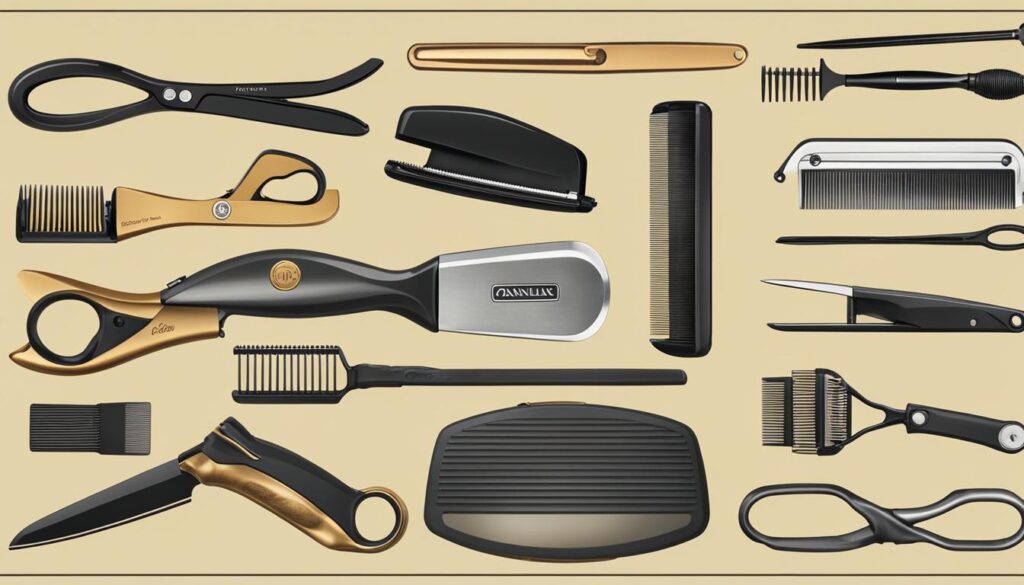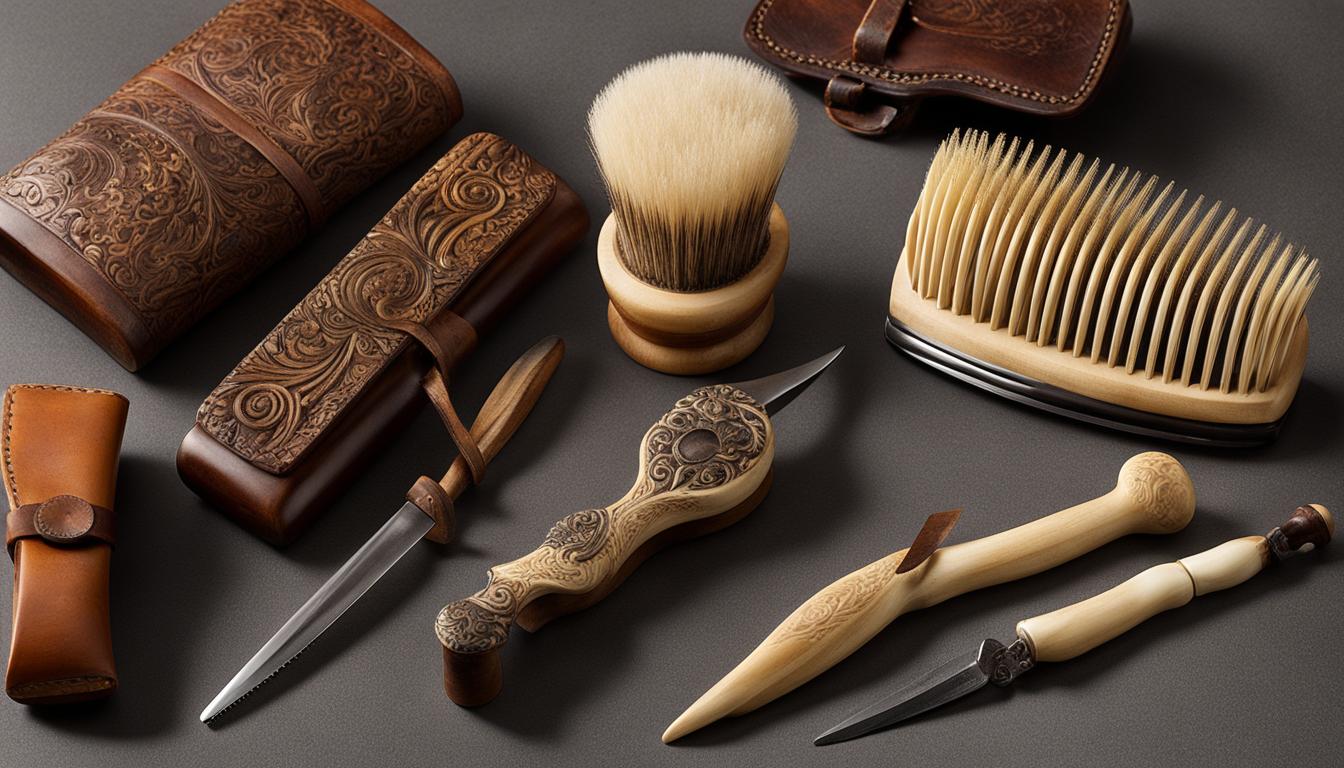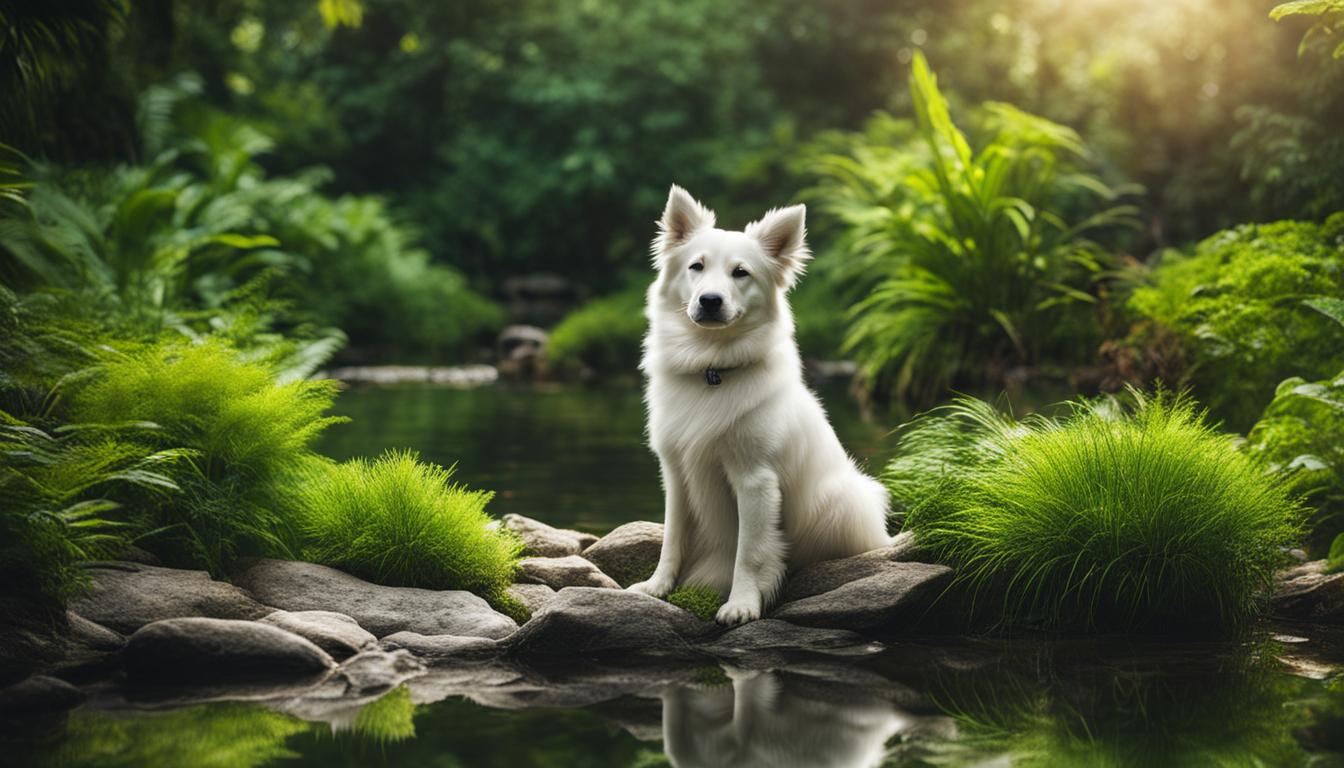Your furry friend deserves the best care, and throughout history, humans have been using a variety of tools to keep our canine companions looking their best. From ancient times to the present day, dog grooming has evolved alongside the bond we share with our four-legged friends. Let’s take a journey into the past and explore the fascinating history of dog grooming tools.
Key Takeaways:
- Ancient civilizations had basic tools like brushes and combs to groom their dogs.
- Grooming became an art form, with aesthetic cuts and styles emerging.
- Electric clippers revolutionized the industry in the 20th century.
- Professional grooming education and certifications ensure high-quality services.
- The grooming industry is currently undergoing discussions about regulation and licensing.
The Development of Electric Dog Clippers and Modern Grooming Tool Advancements
The 20th century witnessed significant advancements in the world of dog grooming tools. One of the most revolutionary developments was the introduction of electric dog clippers. These innovative tools completely transformed the grooming industry, allowing groomers to achieve precise and efficient cuts. By replacing the manual hand shears that were previously used, electric clippers elevated grooming practices to a whole new level.
Electric clippers brought numerous benefits to groomers and their furry clients. The speed and accuracy offered by these tools allowed groomers to work more efficiently, reducing grooming time while maintaining top-quality results. Additionally, the electric clippers’ adjustable blades made it easier to achieve different hair lengths and styles, enhancing the versatility of grooming techniques.
But the advancements didn’t stop at electric clippers. Grooming shears and scissors also underwent significant changes. Manufacturers began experimenting with new designs and materials, optimizing cutting ability and comfort for groomers. The development of ergonomic handles and lightweight materials made it easier for groomers to handle the tools for extended periods, reducing fatigue and improving overall grooming experience.
Companies catering to the grooming industry continued to innovate, introducing specialized tools to address specific grooming needs. Dematting tools, shedding blades, and specialized combs became staples in groomers’ toolkits. These innovative grooming tools allowed groomers to tackle common grooming challenges more effectively, providing better results and ensuring the comfort of their furry clients.
| Advancements in Grooming Tools | Impact on Grooming Practices |
|---|---|
| Electric Dog Clippers | Efficiency and precision in grooming, reduced grooming time |
| Grooming Shears and Scissors | Ergonomic designs for improved comfort, lightweight materials for reduced fatigue |
| Specialized Tools (Dematting, Shedding, Combs) | Addressing specific grooming needs, enhanced results and comfort for pets |
The Evolution Continues:
“The advancements in grooming tools have truly transformed the industry. Electric clippers have made grooming quicker and more precise, while specialized tools have helped groomers address specific challenges. It’s an exciting time to be a professional groomer!”
As we look to the future, it’s evident that the grooming industry will continue to evolve. We can expect further advancements in grooming tool technology as manufacturers strive to meet the needs and expectations of both groomers and pet owners. With each new innovation, groomers will have the opportunity to refine their skills and offer even better grooming experiences for our beloved canine friends.
So, whether you’re a professional groomer or a pet owner looking for the best grooming services, be prepared to embrace the ongoing evolution of dog grooming tools. The future promises exceptional grooming experiences and a deeper bond between groomers, pets, and their owners.

The Impact of Vocational Grooming Schools and Certifications on the Industry
As the grooming industry grew in popularity and demand, the need for standardized education and certifications became apparent. In the 1960s, vocational grooming schools began to emerge, providing aspiring groomers with comprehensive training programs. These schools taught students the essential skills and techniques required for professional grooming, including the proper use of grooming tools and equipment.
During the 1970s and 80s, visionary groomers recognized the importance of professional organizing and training. This led to the formation of professional associations and certifications that aimed to establish industry standards. Grooming pioneers such as Sam Kohl and John Nash played pivotal roles in shaping the grooming profession and advocating for high-quality grooming practices.
The Evolution of Grooming Education
Today, there are several respected professional grooming certifications available, including the International Professional Groomers (IPG), National Dog Groomers Association of America (NDGAA), and International Society of Canine Cosmetologists (ISCC). These certifications not only validate a groomer’s competence and expertise but also enhance their professional credibility.
| Certification | Description |
|---|---|
| International Professional Groomers (IPG) | A globally recognized certification that sets high standards for grooming professionals. |
| National Dog Groomers Association of America (NDGAA) | A leading association that offers comprehensive certification programs tailored to different grooming specialties. |
| International Society of Canine Cosmetologists (ISCC) | A prestigious certification that focuses on advanced grooming techniques and creative styling. |
These certifications not only validate a groomer’s competence and expertise but also enhance their professional credibility. They demonstrate a commitment to ongoing learning and staying abreast of the latest grooming techniques and trends. Grooming schools and certifications have played a vital role in raising the bar for the industry, ensuring that groomers provide the highest quality care for their furry clients.
By obtaining professional certifications and engaging in continued education, groomers can further their careers and gain a competitive edge in the industry. These credentials not only benefit groomers themselves but also provide peace of mind to pet owners who seek the best care for their beloved companions.

The Current State of Groomer Licensing and the Potential for Regulation
When it comes to the pet grooming profession, you may be surprised to learn that there is currently a lack of regulation in the United States. Unlike other professions that require licensing and standardized training, groomers are not currently required to meet any specific qualifications. However, discussions surrounding the need for groomer licensing and regulation have been gaining momentum in recent years.
The lack of regulation in the grooming industry has raised concerns about the safety and well-being of pets. Without standardized training and competency standards, there is a potential risk of inexperienced or unqualified individuals handling animals during grooming procedures. This has led to calls for increased oversight and the establishment of minimum training requirements.
While there are currently no national-level licensing laws for groomers in the United States, some states, such as New York, California, and New Jersey, have made attempts to introduce grooming regulations. These proposed laws aim to set minimum training and competency standards for groomers, ensuring that pets receive the highest level of care and attention during grooming sessions.
The Future of Grooming Industry Regulation
The future of groomer licensing and regulation remains uncertain, but it is clear that changes are on the horizon. As discussions continue and awareness grows about the need for standardized training and competency standards, it is likely that we will see more states considering the implementation of grooming regulations. Additionally, voluntary certifications, such as those offered by professional grooming associations, may become more widely recognized and encouraged within the industry.
Whether or not groomer licensing becomes a requirement, it is important for pet owners and groomers alike to prioritize the safety and well-being of animals. Opting for groomers who have received professional training, certifications, or have a proven track record of providing high-quality care can help ensure that your furry friends receive the best grooming experience possible. It’s always a good idea to do your research and ask questions about a groomer’s qualifications before entrusting them with your pet’s care.
In conclusion, while the pet grooming industry currently lacks mandatory licensing and regulation, there is growing recognition of the need for standardized training and competency standards. The potential for groomer licensing laws exists, and it is important for pet owners and groomers to stay informed and engaged in discussions surrounding the future of the industry. Prioritizing the safety and well-being of pets should always be at the forefront of the grooming profession.
| Prospective Regulation | Potential Impact |
|---|---|
| Standardized Training | Ensures groomers are equipped with the necessary skills and knowledge for safe and effective pet grooming. |
| Minimum Competency Standards | Provides a benchmark for the quality of grooming services and ensures consistent levels of care across the industry. |
| Improved Pet Safety | Reduces the risk of accidents or mishandling during grooming procedures, prioritizing the well-being of animals. |
| Enhanced Professionalism | Elevates the status of the grooming profession by establishing recognized standards and qualifications. |
Embracing the Evolution of Dog Grooming Tools
The world of dog grooming has come a long way, thanks to the remarkable progression of grooming equipment. From ancient brushes and combs to the advent of electric clippers and specialized tools, the grooming industry has witnessed a transformative evolution. As we look to the future, it’s essential to embrace innovative grooming techniques and stay informed about the potential changes that lie ahead.
With the ever-growing demand for top-notch grooming services, the future of the grooming industry is bright. Advancements in grooming equipment have led to a higher level of precision and efficiency, enabling groomers to create stunning cuts and styles. From ergonomic clippers to state-of-the-art dematting tools, groomers now have a wide array of options at their disposal, allowing them to cater to specific grooming needs with ease.
As the industry continues to evolve, staying up-to-date with the latest grooming techniques and tools is crucial. Remaining open to embracing new methods will not only enhance your skills as a groomer but also ensure that you can consistently deliver exceptional care and styling to your furry clients. The future of dog grooming holds endless possibilities, and by embracing these evolutions, you can position yourself at the forefront of the industry.
While the grooming industry moves forward, it’s important to stay informed about potential regulations and licensing. As discussions about standardization and safety arise, staying actively involved in shaping the future of the profession will be paramount. By participating in industry associations and obtaining professional certifications, you can contribute to creating a professional landscape that prioritizes the well-being of pets and ensures the continued growth of the grooming industry.
FAQ
What is the history of dog grooming tools?
Dog grooming has a long and fascinating history that dates back thousands of years. In ancient times, humans and proto-dogs co-evolved, and early humans may have groomed these early dogs as a sign of gratitude for the protection they provided. The earliest records of professional dog groomers come from the Middle Ages, where kennel boys cared for hunting and herding dogs on feudal estates in Europe.
How have grooming tools evolved over time?
The grooming profession gradually evolved into an art form, with aesthetic cuts and styles emerging. In the 20th century, electric dog clippers revolutionized the industry, allowing groomers to achieve precision cuts more efficiently. Alongside electric clippers, other grooming tools also underwent advancements, with new designs and materials being used to improve their cutting ability.
What is the impact of vocational grooming schools and certifications?
In the 1960s, vocational grooming schools started to emerge, offering comprehensive training programs for aspiring groomers. These schools taught students the fundamentals of grooming, including the proper use of grooming tools and techniques. Today, there are several respected professional grooming certifications that demonstrate a groomer’s competence and expertise, ensuring high-quality grooming services for clients.
Is groomer licensing regulated in the United States?
The pet grooming profession in the United States is largely unregulated. There are currently no required training or licensing regulations for groomers. However, discussions about the need for standardized training and licensing to ensure the safety and well-being of pets have been ongoing. Some states, such as New York, California, and New Jersey, have proposed licensing laws to establish minimum training and competency standards for groomers.
How can groomers embrace the evolution of grooming tools?
Groomers are encouraged to stay informed and participate in shaping the future of the profession. Embracing new grooming techniques and innovative tools will ensure that groomers continue to provide exceptional care and styling for our beloved canine companions.





